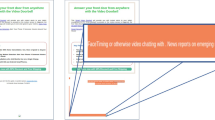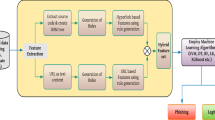Abstract
Filtering spam voice calls are a still major challenge in today’s technology contrary to SMS or email-based spamming. A numerical measure of the trust between users can help us filter calls based on relevance. Given the abundance of user-generated information available from the huge number of online devices, we can harness the power of this data to develop software adapting to user behavior. Existing research works for trust computation face various challenges when it comes to global applicability and understandability of trust values. Our investigation includes detailed surveillance of user call patterns based on the call data available from mobile devices and proposes a novel approach to filter calls that are of higher relevance to users based on their call-trust values. Our implementation realizes the diversity in call patterns of different people due to varying usage and uses classification and clustering algorithms to generate personalized, accurate numerical, and categorical trust values for every user. Categorical trust makes it easier to apply and understand trust ratings on a global scale. The implementation also incorporates a cloud facility to crowd-source trust values from multiple users, in a single database to generate the global trust of a user which can be used for spam filtering on a global scale. A software named “mTrust” is developed in this work for the future generation of a trustworthy mobile cloud network.











Similar content being viewed by others
References
Bok, K., Yoon, S., & Yoo, J. (2018). Trust evaluation of multimedia documents based on extended provenance model in social semantic web. Multimedia Tools and Applications, 1–22.
Anakath, A. S., Rajakumar, S., & Ambika, S. (2017). Privacy preserving multi factor authentication using trust management. Cluster Computing, 1–7.
Singh, O., Singh, J., & Singh, R. Multi-level trust-based intelligence intrusion detection system to detect the malicious nodes using elliptic curve cryptography in MANET. Cluster Computing, 1–13.
Kim, M., & Park, S. O. (2013). Group affinity based social trust model for an intelligent movie recommender system. Multimedia Tools and Applications, 64(2), 505–516.
Li, H., Zhang, S., Hu, Y., Shi, J., & Zhong, Z.-m. (2017). Research of social recommendation based on social tag and trust relation. Cluster Computing, 1–11.
Santhi, G., Maria, S., Anna, W., & Sengutuvan, P. (2013). Fuzzy rule based novel approach to spam filtering. International Journal of Computer Applications (0975 – 8887), 71(14).
Chakraborty, S., & Mondal, B. (2012). Spam mail filtering technique using different decision tree classifiers through data mining approach—a comparative performance analysis. International Journal of Computer Applications (0975–888), 47, 16–26.
Ramchoun, H., Idrissi, M. A. J., Ghanou, Y., & Ettaouil, M. (2016). Multilayer perceptron: architecture optimization and training. IJIMAI, 4(1), 26–30.
Hsu, C.-W., Chang, C.-C., & Lin, C.-J. (2003). A practical guide to support vector classification.
Guo, G., Wang, H., Bell, D., Bi, Y., & Greer, K. (2003). KNN Model-based approach in classification. OTM on the move to meaningful internet systems 2003: CoopIS, DOA, and ODBASE, pp. 986–996.
Chen, S., Wang, G., & Jia, W. (2013). A trust model using implicit call behavioral graph for mobile cloud computing. Cyberspace safety and security, pp. 387–402.
De, D., & De, B. C. (2018). TBFN: Trust based friend network deisgn by analyzing user’s voice call and SMS pattern. Wireless Personal Communication, Springer.
Xin, L., Leyi, S., Yao, W., Zhaojun, X., & Wenjing, F. (2013). A dynamic trust conference algorithm for social network. Eighth international conference on P2P, parallel, grid, cloud and internet computing.
Oh, H.-K., Kim, J.-W., Kim, S.-W., & Lee, K. (2018). A unified framework of trust prediction based on message passing. Cluster Computing, 1–13.
Ju, C., Wang, J., & Xu, C. (2018). A novel application recommendation method combining social relationship and trust relationship for future internet of things. Multimedia Tools and Applications.
Adali, S., Escriva, R., Goldberg, M. K., Hayvanovych, M., Magdon-Ismail, M., Szymanski, B. K., Wallace, W. A., & Williams, G. (2010). Measuring behavioral trust in social networks. IEEE international conference on intelligence and security informatics.
Kim, M., & Park, S. O. (2013). Trust management on user behavioral patterns for a mobile cloud computing. Cluster Computing, 16(4), 725.
Zhao, B., Xiao, C., Zhang, Y., Zhai, P., & Wang, Z. (2018). Assessment of recommendation trust for access control in open networks. Cluster Computing.
Hosseini, M., Angelopoulos, C. M., Chai, W. K., & Kundig, S. (2018). Crowdcloud: A crowdsourced system for cloud infrastructure. Cluster Computing, 1–16.
Chaisamran, N., Okuda, T., Blanc, G., & Yamaguchi, S. (2011). Trust-based VoIP spam detection based on call duration and human relationships. IEEE.
Singh, S. P., & Yadav, A. Study of K-Means and enhanced K-Means clustering algorithm. International Journal of Advanced Research in Computer Science.
Aitkin, M., & Foxall, R. (2003). Statistical modelling of artificial neural networks using the multi-layer perceptron. Statistics and Computing, 13, 227–239.
Jia, G., Chen, R., Wang, D.-C., Tsai, J. J. P., & Al-Hamadi, H. (2019). Trust-based IoT cloud participatory sensing of air quality. Wireless Personal Communications, 1–14.
Riganelli, O., Micucci, D., & Mariani, L. (2018). From source code to test cases: A comprehensive benchmark for resource leak detection in Android apps. Software: Practice and experience, pp. 1–9.
Dev, J., Das, S., Rashidi, Y., & Camp, L. J. (2019). Personalized WhatsApp privacy: Demographic and cultural influences on Indian and Saudi users: SSRN.
Cheok, A. D., Edwards, B., & Muniru, I. (2017). Human behavior and social networks. In R. Alhajj & J. Rokne (Eds.), Encyclopedia of social network analysis and mining. New York, NY: Springer.
Ramjee, P., & Ruggieri, M. (2016). Special Issue on Human bond communications (HBC). Wireless Personal Communications, 88(1), 1–4.
De, D. (2016). Mobile cloud computing: Architectures, algorithms, and applications. CRC Press.
Author information
Authors and Affiliations
Corresponding author
Additional information
Publisher's Note
Springer Nature remains neutral with regard to jurisdictional claims in published maps and institutional affiliations.
Rights and permissions
About this article
Cite this article
Bhowmik, A., De, D. mTrust: Call Behavioral Trust Predictive Analytics Using Unsupervised Learning in Mobile Cloud Computing. Wireless Pers Commun 117, 483–501 (2021). https://doi.org/10.1007/s11277-020-07879-x
Accepted:
Published:
Issue Date:
DOI: https://doi.org/10.1007/s11277-020-07879-x




